3D printing in paleontology - we “resurrect” organisms that died out millions of years ago
In the last article, The Digital Present and Future of Paleontology, I briefly highlighted the main aspects in the development of paleontology using modern digital technologies. In particular, such a task as 3D modeling of fossil animals and plants was described.
But progress does not stand still, and until recently it was considered science fiction, in some places, it is a workflow in some organizations. I mean printing with 3D printers.
I am an employee of the Darwin Museum (Fig. 1), which, fortunately, has the ability and technology to produce such models and I would like to describe the process of building animal models with which we decided to start updating the expositions.
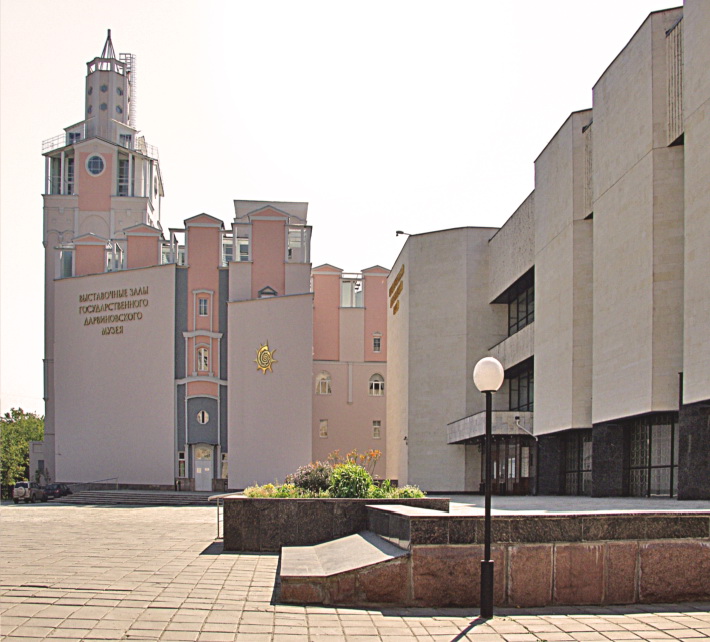
Fig. 1. Darwin Museum, Moscow, ul. Vavilova, 57 (metro Akademicheskaya)
As the first trial models, we selected the fauna of the Burgess shales (Fig. 2). This unique location is located in the Rocky Mountains of Canada and has a Middle Cambrian age (about 510 million years). At the same time, it is the richest in diversity location of Cambrian minerals in the world.
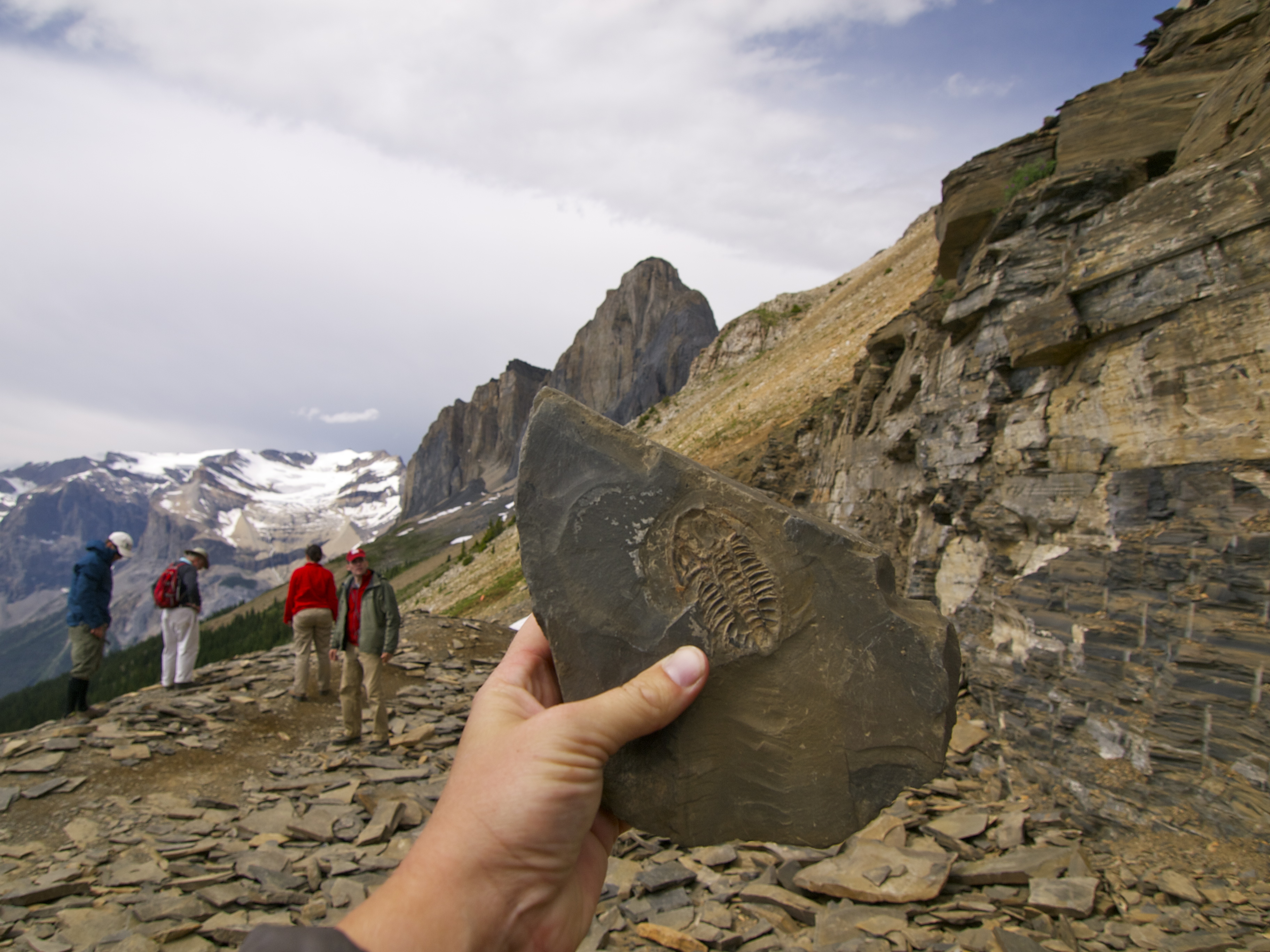
Fig. 2. Burgess shales
A little additional information about the history of the discovery of the location.
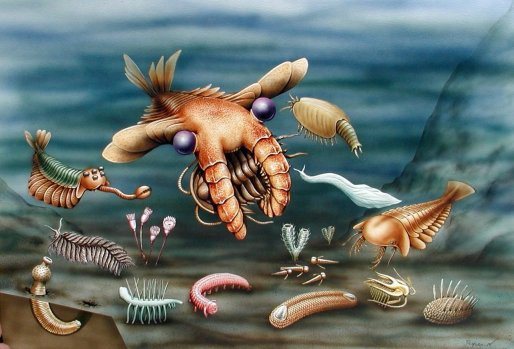
Fig. 3. Reconstruction of the animal fauna of the Burgess Shale
We selected several of the most famous and interesting representatives of the Burgess Shales fauna based on their morphology, namely the following five species of different taxonomic groups:
Opabinia regalis
Pikaia gracilens
Anomalocaris sp.
Hallucigenia sparsa
Wiwaxia sp.
Opabinia regalis- representative of the arthropod class Dinocarida. The pioneer of Opabinia, Charles Doolittle Walcott, named it after the local mountain - the Opabin Pass on Mount Hungaby in the Canadian Rockies. Thirty samples of opabinium are currently known, and each of them has a size in the range from 40 to 70 mm. The most notable feature of opabinia are its five eyes, located on the back of the head. These eyes were probably used by animals for food. Due to its flexible body, it is not known whether opabinia led a pelagic or benthic lifestyle.
The first reconstruction of opabinia was presented in the work of Hutchinson (Hutchinson, 1930) and represented the opabinia of an inverted, relatively dorsal side (Fig. 4, a).
We used as a basis the most recent reconstruction of opabinia (Fig. 4f; Fig. 2), published several years ago (Zhang, Briggs, 2007).
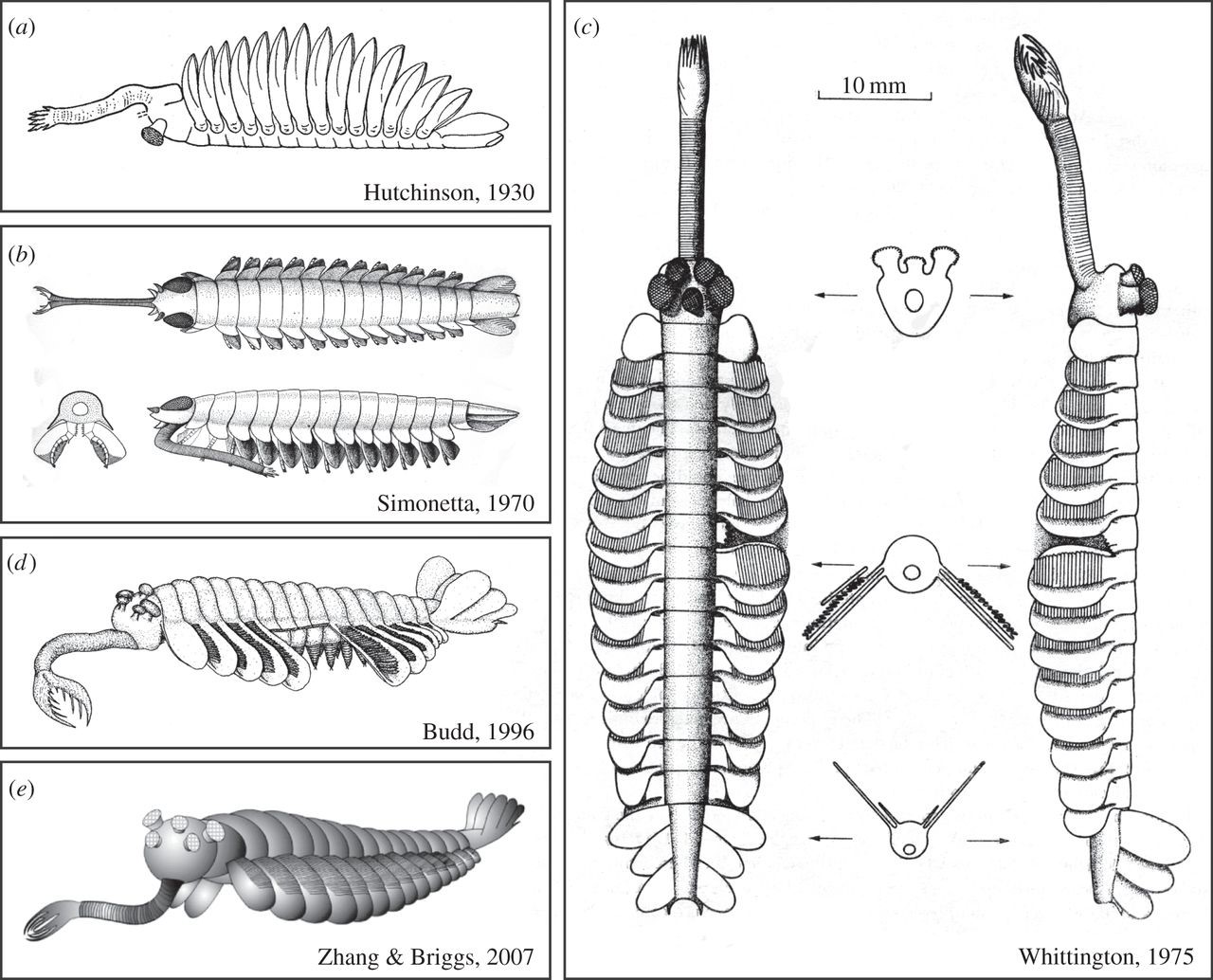
Fig. 4. Evolution of reconstructions of Opabinia regalis in the works of various authors
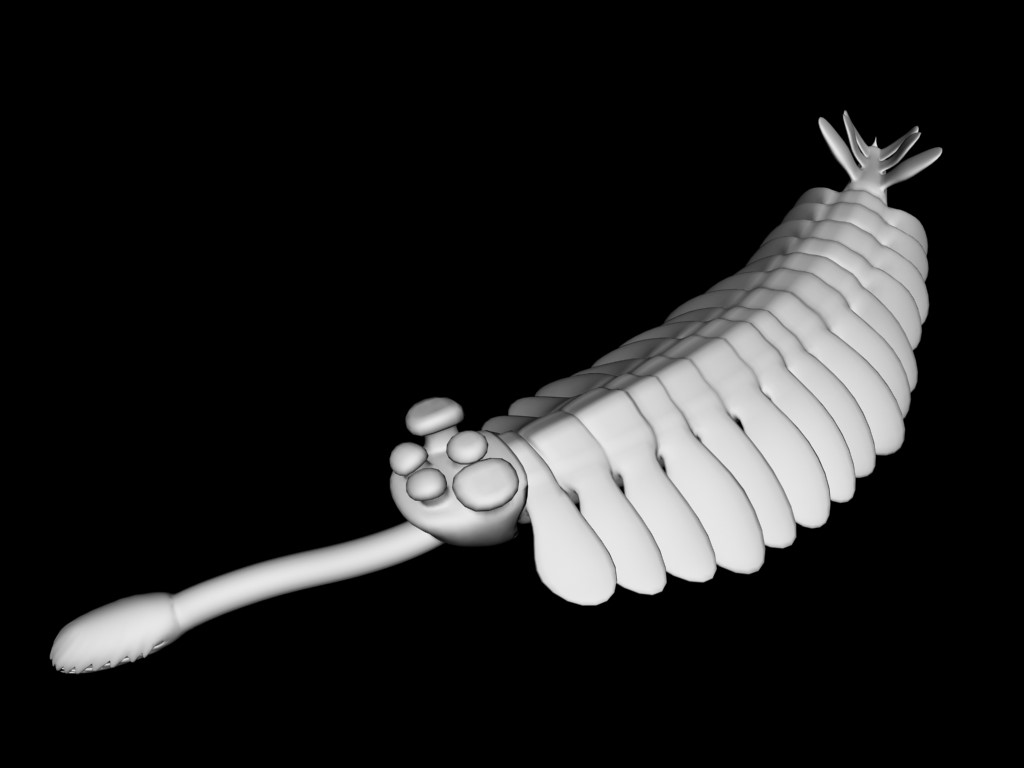
Fig. 5. Reconstruction of Opabinia regalis by 3-D modeler E.Yu. Makhnev
Pikaia gracilens is a small primitive chordate animal. The body length of adults reached from 1.5 to 6 cm, on average it was 4 cm. The body height was from 7 to 16% of its length, on average, about 11%.
The body of the pikaya is elongated, rounded in front and compressed laterally in the remaining parts. A narrow ridge resembling a fin stretched along the ventral side. Another crest, although not so high, was located on the dorsal side.
The head was very small, divided into two rounded lobes, on which there was a pair of tentacles. There is reason to believe that these tentacles were resilient, since after the death of the animal they usually remained straight, judging by the preserved prints. Most likely, they performed the function of the organs of smell and touch. At the base of the head on its lower side was a mouth opening. No organs similar to the eyes were found (Fig. 6, 7).
Behind the head, on either side of the pharynx, there were 9 pairs of branching appendages, which are interpreted by researchers as external gills. Small rounded spots are sometimes visible near the bases of these appendages, possibly corresponding to gill slits (Morris and Caron, 2012).
The approved reconstructions of pikaya (Gould, 1991) and (Fig. 6) are taken as the basis.
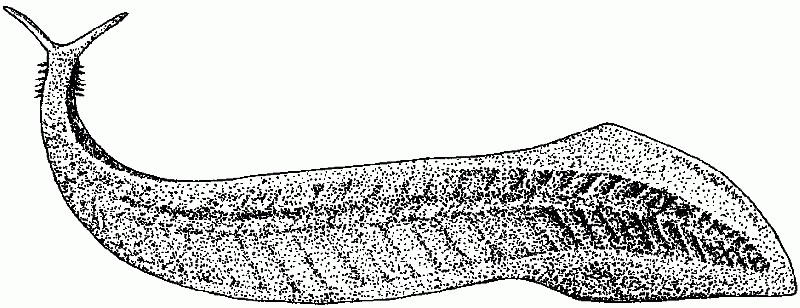
Fig. 6. Reconstruction of pikaya (Gould, 1991).
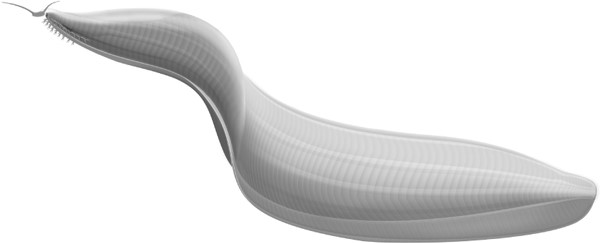
Fig. 7. A newer possible reconstruction of the appearance of Pikaia gracilens. Image from the article under discussion in Biological Reviews (Simon, Caron, 2012)

Fig. 8. Reconstruction of Pikaia gracilens, performed by 3-D modeler E.Yu. Makhnev.
Anomalocaris canadensis is a species of fossil arthropods from the class of dinocarids (Dinocarida). They lived in the seas, used flexible lateral lobes for swimming. One of the largest organisms known from the Cambrian sediments: body length could reach 60 cm and even 2 m.
The anomalocaris remains could not be identified for a long time - for the first time discovering its remains, scientists could not understand what their owner looked like. When his long oral appendages were found in 1892, paleontologists decided that they belonged to some primitive representative of crustaceans. And they found parts of a ring-shaped mouth discovered in 1911 as the remains of an ancient jellyfish. It was only in the 1980s that it became clear that the oral appendages and mouth plates belonged to the same animal (Fig. 9, 10).
It was shown that the ancient anomalocaris had excellent vision, which was provided by a pair of faceted eyes. Vigilance of anomalocaris is provided by at least 16 thousand hexagonal lenses. The presence of such complex eyes in anomalocaris suggests that facet vision began to develop in arthropods much earlier than previously thought. It is noteworthy that, probably, according to visual acuity, the ancient anomalocaris was superior to many of its modern relatives. So, for comparison, the number of lenses in the eye of the fly is about 4000, and in the eye of the ant is about 100. It is noted that the new results are likely to cause controversy about the evolution of the exoskeleton - in particular, how this evolution relates to the evolution of the eyes themselves (Whittington , Briggs, 1985).

Fig. 9. а - Model Anomalocaris canadensis (Whittington, Briggs, 1996), b - Model Anomalocaris at National Dinosaur Museum, Canberra, Australia. (Wikipedia).

Fig. 10. Reconstruction of Anomalocaris canadensis, performed by 3-D modeler E.Yu. Makhnev.
Hallucigenia sparsa is a species of fossil invertebrate from the Xenusia class. Discovered by the English paleontologist Simon Conway-Morris in 1977. The remains were first found in the Burgess shales. Further hallucination was found in Chinese Chenchang. Outwardly, it looks like a worm with two rows of stilt legs and dorsal spines. They were the ancestral group for the modern Onychophore and the sister group of the Tardigrades and arthropods (Euarthropoda).
Hallucigenic has an elongated head with simple eyes (Fig. 11-12), a circle of sclerotized elements in the oral cavity and acicular teeth in the front of the digestive tract.

Fig. 11. a - Reconstruction (Marianne Collins in “Wonderful Life” Gould SJ 1991), b - Photo of the Hallucigenia sparsa holotype (Smithsonian Institute), c - Reconstruction of the Hallucigenia sparsa paleo illustrator Marc Boulevard, taken as the basis for modeling.

Fig. 12. Reconstruction of Hallucigenia sparsa, performed by 3-D modeler E.Yu. Makhnev.
Wwaxia- a genus of soft-bodied scaly animals, known only from fossils found for the first time in the Canadian deposits of Burgess shales (140 specimens were found there). Estimated lifetime is from the end of Lower Cambrian to Middle Cambrian. Organisms are mostly known for disseminated sclerites; the articulated specimens that were found are from 3.4 millimeters (0.13 inches) to a little over 50.8 mm (2 inches) in length. The average size of the found remains is 30 mm. The appearance is somewhat reminiscent of a miniature porcupine with spikes and scales. The spikes were supposed to serve for protection. Subsequently, the fossils of this animal were found all over the world, which suggests that vivaxia was widespread during the Cambrian era.
The exact taxonomic relationship of the genus is the subject of ongoing debate among paleontologists.

Fig. 13. Reconstruction of Wiwaxia

Fig. 14. Reconstruction of Wiwaxia sp., Performed by 3-D modeler E.Yu. Makhnev.
Print
The Darwin Museum has its own Fab Lab.
Our laboratory is called CMIT ( Center for Youth Innovative Creativity ). It is in it that there are several wonderful new 3D printers. The most interesting and suitable for printing our models was the gypsum printer brand ZPrinter450.
Further, in order not to bore the writings, I will cite the printing process in the photoset.

Fig. 15. The printing process. a) printer ZPrinter450 b) filling the beds with gypsum c) published a couple of hours, but can not see the object - it is necessary to clean

Fig. 16. The cleaning process. a) I clean the excess gypsum with a vacuum cleaner b) something looms)

Fig. 17. Impregnation. a) the sample is impregnated with a solution for the fortress b) the author with the finished Opabinia c) made a stand on the cutter for it
After several hours of printing and impregnation, our “Burgess Shale Soup Fauna Set” is ready!

Fig. 18. a) Pikaia gracilens b) Anomalocaris sp.

Fig. 19. a) Hallucigenia sparsa b) Wiwaxia sp.
Actually, this was our “first test” of the pen printing models of fossil animals on a 3D printer. Now we are working on the color of the models and are creating a robotic model of an ancient arthropod, printed on another printer (printing plastic). But more about that in the next note.
Gould, Stephen Jay. Wonderful Life: Burgess Shale and the Nature of History, Vintage, 2000
Hutchinson, GE 1930. Restudy of some Burgess Shale fossils. Proceedings of the US National Museum, 78: 1-11.
Conway Morris, S .; Caron, JB (2012) "Pikaia gracilens Walcott, a stem-group chordate from the Middle Cambrian of British Columbia." Biological Reviews 87: 480-512.
Whittington HB , Briggs DEG (1985) The largest Cambrian animal Anomalocaris, Burgess Shale, British Columbia. Philos T RoySoc B 390: 569-609
Zhang, X., Briggs, DEG (2007). The nature and significance of the appendages of Opabinia from the Middle Cambrian Burgess Shale. Lethaia 40, 161-173. Wikipedia.org
materials
But progress does not stand still, and until recently it was considered science fiction, in some places, it is a workflow in some organizations. I mean printing with 3D printers.
I am an employee of the Darwin Museum (Fig. 1), which, fortunately, has the ability and technology to produce such models and I would like to describe the process of building animal models with which we decided to start updating the expositions.

Fig. 1. Darwin Museum, Moscow, ul. Vavilova, 57 (metro Akademicheskaya)
Preamble
As the first trial models, we selected the fauna of the Burgess shales (Fig. 2). This unique location is located in the Rocky Mountains of Canada and has a Middle Cambrian age (about 510 million years). At the same time, it is the richest in diversity location of Cambrian minerals in the world.

Fig. 2. Burgess shales
A little additional information about the history of the discovery of the location.
Fossil remains in the Burgess shales were first discovered by paleontologist Charles Doolittle Walcott in 1909 at the end of his field season. In 1910, he returned there with his son and began excavations near the area called the Fossil Ridge. He returned to the excavations every year until 1924 - by the time he was already 74 years old, he discovered more than 65 thousand samples. Walcott was busy describing these samples until his death in 1927. Walcott's mistake was that he tried to put all the fossil remains in taxa known by then, and many of them looked like funny things. Only in 1962 there was a fundamental revision of the classification of Burgess residues, which was carried out by Alberto Simonetta. This led to a new explosion of interest in the area, as it turned out that many open organisms are something new, previously unknown. The number of paleontological remains found in the formation is so great that the term “Burgess shale fauna” has come into use.
An analysis of the Burgess fossil shale by Whittington and his colleagues in the 1970s formed the basis of Gould’s book Amazing Life, which opened the Cambrian explosion to the general public (Fig. 3).
Arthropods are the most common among the Burgess fossil shales, however many of them are unusual and difficult to classify.

Fig. 3. Reconstruction of the animal fauna of the Burgess Shale
Types and Models
We selected several of the most famous and interesting representatives of the Burgess Shales fauna based on their morphology, namely the following five species of different taxonomic groups:
Opabinia regalis
Pikaia gracilens
Anomalocaris sp.
Hallucigenia sparsa
Wiwaxia sp.
Opabinia regalis- representative of the arthropod class Dinocarida. The pioneer of Opabinia, Charles Doolittle Walcott, named it after the local mountain - the Opabin Pass on Mount Hungaby in the Canadian Rockies. Thirty samples of opabinium are currently known, and each of them has a size in the range from 40 to 70 mm. The most notable feature of opabinia are its five eyes, located on the back of the head. These eyes were probably used by animals for food. Due to its flexible body, it is not known whether opabinia led a pelagic or benthic lifestyle.
The first reconstruction of opabinia was presented in the work of Hutchinson (Hutchinson, 1930) and represented the opabinia of an inverted, relatively dorsal side (Fig. 4, a).
We used as a basis the most recent reconstruction of opabinia (Fig. 4f; Fig. 2), published several years ago (Zhang, Briggs, 2007).

Fig. 4. Evolution of reconstructions of Opabinia regalis in the works of various authors

Fig. 5. Reconstruction of Opabinia regalis by 3-D modeler E.Yu. Makhnev
Pikaia gracilens is a small primitive chordate animal. The body length of adults reached from 1.5 to 6 cm, on average it was 4 cm. The body height was from 7 to 16% of its length, on average, about 11%.
The body of the pikaya is elongated, rounded in front and compressed laterally in the remaining parts. A narrow ridge resembling a fin stretched along the ventral side. Another crest, although not so high, was located on the dorsal side.
The head was very small, divided into two rounded lobes, on which there was a pair of tentacles. There is reason to believe that these tentacles were resilient, since after the death of the animal they usually remained straight, judging by the preserved prints. Most likely, they performed the function of the organs of smell and touch. At the base of the head on its lower side was a mouth opening. No organs similar to the eyes were found (Fig. 6, 7).
Behind the head, on either side of the pharynx, there were 9 pairs of branching appendages, which are interpreted by researchers as external gills. Small rounded spots are sometimes visible near the bases of these appendages, possibly corresponding to gill slits (Morris and Caron, 2012).
The approved reconstructions of pikaya (Gould, 1991) and (Fig. 6) are taken as the basis.

Fig. 6. Reconstruction of pikaya (Gould, 1991).

Fig. 7. A newer possible reconstruction of the appearance of Pikaia gracilens. Image from the article under discussion in Biological Reviews (Simon, Caron, 2012)

Fig. 8. Reconstruction of Pikaia gracilens, performed by 3-D modeler E.Yu. Makhnev.
Anomalocaris canadensis is a species of fossil arthropods from the class of dinocarids (Dinocarida). They lived in the seas, used flexible lateral lobes for swimming. One of the largest organisms known from the Cambrian sediments: body length could reach 60 cm and even 2 m.
The anomalocaris remains could not be identified for a long time - for the first time discovering its remains, scientists could not understand what their owner looked like. When his long oral appendages were found in 1892, paleontologists decided that they belonged to some primitive representative of crustaceans. And they found parts of a ring-shaped mouth discovered in 1911 as the remains of an ancient jellyfish. It was only in the 1980s that it became clear that the oral appendages and mouth plates belonged to the same animal (Fig. 9, 10).
It was shown that the ancient anomalocaris had excellent vision, which was provided by a pair of faceted eyes. Vigilance of anomalocaris is provided by at least 16 thousand hexagonal lenses. The presence of such complex eyes in anomalocaris suggests that facet vision began to develop in arthropods much earlier than previously thought. It is noteworthy that, probably, according to visual acuity, the ancient anomalocaris was superior to many of its modern relatives. So, for comparison, the number of lenses in the eye of the fly is about 4000, and in the eye of the ant is about 100. It is noted that the new results are likely to cause controversy about the evolution of the exoskeleton - in particular, how this evolution relates to the evolution of the eyes themselves (Whittington , Briggs, 1985).

Fig. 9. а - Model Anomalocaris canadensis (Whittington, Briggs, 1996), b - Model Anomalocaris at National Dinosaur Museum, Canberra, Australia. (Wikipedia).

Fig. 10. Reconstruction of Anomalocaris canadensis, performed by 3-D modeler E.Yu. Makhnev.
Hallucigenia sparsa is a species of fossil invertebrate from the Xenusia class. Discovered by the English paleontologist Simon Conway-Morris in 1977. The remains were first found in the Burgess shales. Further hallucination was found in Chinese Chenchang. Outwardly, it looks like a worm with two rows of stilt legs and dorsal spines. They were the ancestral group for the modern Onychophore and the sister group of the Tardigrades and arthropods (Euarthropoda).
Hallucigenic has an elongated head with simple eyes (Fig. 11-12), a circle of sclerotized elements in the oral cavity and acicular teeth in the front of the digestive tract.

Fig. 11. a - Reconstruction (Marianne Collins in “Wonderful Life” Gould SJ 1991), b - Photo of the Hallucigenia sparsa holotype (Smithsonian Institute), c - Reconstruction of the Hallucigenia sparsa paleo illustrator Marc Boulevard, taken as the basis for modeling.

Fig. 12. Reconstruction of Hallucigenia sparsa, performed by 3-D modeler E.Yu. Makhnev.
Wwaxia- a genus of soft-bodied scaly animals, known only from fossils found for the first time in the Canadian deposits of Burgess shales (140 specimens were found there). Estimated lifetime is from the end of Lower Cambrian to Middle Cambrian. Organisms are mostly known for disseminated sclerites; the articulated specimens that were found are from 3.4 millimeters (0.13 inches) to a little over 50.8 mm (2 inches) in length. The average size of the found remains is 30 mm. The appearance is somewhat reminiscent of a miniature porcupine with spikes and scales. The spikes were supposed to serve for protection. Subsequently, the fossils of this animal were found all over the world, which suggests that vivaxia was widespread during the Cambrian era.
The exact taxonomic relationship of the genus is the subject of ongoing debate among paleontologists.

Fig. 13. Reconstruction of Wiwaxia

Fig. 14. Reconstruction of Wiwaxia sp., Performed by 3-D modeler E.Yu. Makhnev.
The Darwin Museum has its own Fab Lab.
Fab Lab (Fab Lab) is a production and educational workshop where you can make almost everything. The main task of the fablab is to help innovators implement their designs from ideas to prototyping, searching for marketing solutions and creating innovative products.
Our laboratory is called CMIT ( Center for Youth Innovative Creativity ). It is in it that there are several wonderful new 3D printers. The most interesting and suitable for printing our models was the gypsum printer brand ZPrinter450.
Further, in order not to bore the writings, I will cite the printing process in the photoset.

Fig. 15. The printing process. a) printer ZPrinter450 b) filling the beds with gypsum c) published a couple of hours, but can not see the object - it is necessary to clean

Fig. 16. The cleaning process. a) I clean the excess gypsum with a vacuum cleaner b) something looms)

Fig. 17. Impregnation. a) the sample is impregnated with a solution for the fortress b) the author with the finished Opabinia c) made a stand on the cutter for it
After several hours of printing and impregnation, our “Burgess Shale Soup Fauna Set” is ready!

Fig. 18. a) Pikaia gracilens b) Anomalocaris sp.

Fig. 19. a) Hallucigenia sparsa b) Wiwaxia sp.
Actually, this was our “first test” of the pen printing models of fossil animals on a 3D printer. Now we are working on the color of the models and are creating a robotic model of an ancient arthropod, printed on another printer (printing plastic). But more about that in the next note.
Literature
Gould, Stephen Jay. Wonderful Life: Burgess Shale and the Nature of History, Vintage, 2000
Hutchinson, GE 1930. Restudy of some Burgess Shale fossils. Proceedings of the US National Museum, 78: 1-11.
Conway Morris, S .; Caron, JB (2012) "Pikaia gracilens Walcott, a stem-group chordate from the Middle Cambrian of British Columbia." Biological Reviews 87: 480-512.
Whittington HB , Briggs DEG (1985) The largest Cambrian animal Anomalocaris, Burgess Shale, British Columbia. Philos T RoySoc B 390: 569-609
Zhang, X., Briggs, DEG (2007). The nature and significance of the appendages of Opabinia from the Middle Cambrian Burgess Shale. Lethaia 40, 161-173. Wikipedia.org
materials
